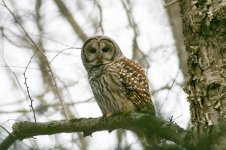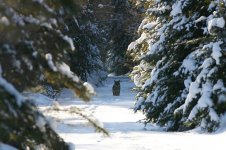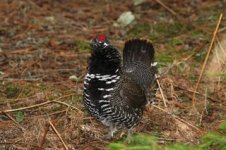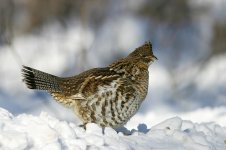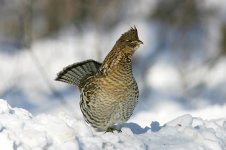
With plunging temperatures and a general exodus of birds, the northern extremes of the American continent are not perhaps amongst the most obvious of destinations for a winter birding trip. However, for a few select species, the season is at its prime - and naturally it was for these that I had planned my visit.
The result was five Snowy Owls, one Boreal Owl, another 24 owls of various species, a good section of raptors, Grey Jays and Boreal Chickadees, two WOLF, a flock of 117 Harlequins, a 'Waxwing Double' and numerous other northern specialities.
Concentrating on four main areas and groups of birds, my journey took me 5700 km through spectacular winter landscapes in both Canada and the north-east of the USA.
Main localities visited included:
1. The Niagara River - one of the best spots in the world for early winter concentrations of gulls, a total of 19 species recorded. Also, as neighbouring waters freeze, influxes of waterfowl.
2. Algonquin Provincial Park - a stunning locality, expansive forests rich in boreal bird species, plus good chances of mammals.
3. Amherst and Wolfe Islands - renowned wintering grounds for owls and raptors, particularly Amherst.
4. The Atlantic Seacoast - mostly Cape Cod and Plum Island in Massachusetts, but also Cape May and New York. Wintering seaduck, alcids, grebes and divers, as well as raptors, owls and passerines.
With temperatures as low as minus 10 C in New York and minus 23 in Algonquin, the region was experiencing conditions considerably colder than usual, but I was actually very lucky with the weather - with the exception of freezing rain on Wolfe Island, other days were either sunny or at least bright.
A trip of this nature does, however, run real risk of being severely impacted by adverse weather, either disrupting birding or simply leaving sites unreachable. Indeed, had I planned my itinerary differently by just a few days, the trip would have been memorable for reasons other than birds - heavy snow and blizzards hit almost all localities either in the days preceding my trip or immediately after I left.
DAILY LOG. Birds and Birding.
18 December. Bumpy Journeys.
Nothing like an eventful start to a trip! After adventures boarding the flight in Vilnius and problems authorising my credit card to pick up a rental car in New York, I was out on the open roads, assuming nothing more could go wrong. It was 6.00 p.m. local time, I settled down for the long drive ahead, admiring the views of the passing Manhattan skyline and clicking on the radio ...oh heck, every station was talking of a massive snow storm approaching, the likes of which had not been seen since 2003, motorists advised to stay off the roads, etc!
With the storm tracking in from the south, it seemed the natural option to try and outrun it, so northward I went, driving into the night towards Canada. An Amtrak train was already reported stuck, its passengers thereafter stranded for more than 24 hours, but the road I took was clear. Seven hundred kilometres north, now in the early hours of the morning and a full 30 hours since I left home, I decided a rest was in order. I crossed the US-Canada border at Niagara Falls, then slept in the car for a couple of hours to await sunrise, time for the birding day to begin.
What a journey!
19 December. Niagara River.
Alive with the aerobatics of tens of thousands of birds, the Niagara River attracts one of the greatest gatherings of gulls in the world. With turbulent waters keeping the river ice-free, vast flocks congregate in early winter, the species mix commonly totalling a dozen or more species, including up to 10% of the global Bonaparte's Gull population. Add to this, impressive concentration of waterfowl and the entire 56 km of river becomes one of the true legendary winter birding localities in all North America.
And into this I began my first day's birding. A mild minus 5 C and a light dusting of snow on the ground. Parked just upstream of the falls, encrusted layers of ice coating road, tree and building alike. Slipped and slithered to the river, stood a moment in awe at the spectacle - clouds of spray rising from the lip of the mighty falls, an incessant roar of water and literally thousands of birds carpeting shingle islands and rocks. Superb stuff, began scanning through - Ring-billed Gulls and American Herring Gulls absolutely everywhere, tens of thousands of them, plus flocks of Bonaparte's Gulls hawking the waters at the fall's edge, most dainty and agile. Amongst the hordes, here and elsewhere on the river, would hide selective specials - a couple of Thayer's Gulls had been reported, a lone California Gull and a dozen or so white-winged gulls, the task of the day to seek them out. Little effort required for the Great Black-backed Gulls dotted amongst the flocks, only a little to find a few Lesser Black-backed Gulls, a scarce bird at the local level. Then hard graft time kicked in, settling beneath a rock wall to start the bird-by-bird search, island after island of birds to check! Many pleasant distractions - a total of 20 Hooded Mergansers, a trio of American Wigeons and the first of many Black Ducks on the trip - then, after an hour of river gazing, the first jackpot of the day. Initially resting on a far shingle bank, there it was, a first-year Thayer's Gull amongst numerous Herring Gulls. A new species for me, I was just congratulating myself and double checking the finer details of identification when suddenly, presumably the result of an unseen falcon, the entire sky was alive with gulls and up went the Thayer's Gull - several splendid close-range fly-bys, then off it drifted, into the mists of the falls and I lost the bird. Not having heart to start my scans again, I left and decided for a quick walk in the woodlands of the nearby Dufferin Island.
Ambushed within seconds by Black-capped Chickadees, cheeky chaps all too happy to use a stretched palm as a mobile food tray. A most enjoyable hour in the wood, the dozen or so chickadees jumping all over me, grabbing sunflower seeds and generally being right little characters. Equally tame, White-breasted Nuthatches, a few Northern Cardinals and Dark-eyed Juncos, plus two Downy Woodpeckers. Nice though these were, I was itching to venture yonder, to the Niagara River Gorge that stretches northward from the falls. With the waters churning and a soup of small fish, these lower reaches of the river truly are the gull hotspots of the region. First stop, the Whirlpool, a 90 degree turn in the gorge forcing the river into a violent spin, the resultant eddies and whitewater a magnet to thousands of Bonaparte's Gulls. From the top of the gorge, with a bird's eye view, amongst the swirls of graceful gulls, a lone Little Gull hawked. A few kilometers further, the Sir Adam Beck Generating Station loomed, the huge turbines offering fish sliced and served to the waiting frenzy of gulls. A tough task indeed here, amongst the tens of thousands of mixed gulls, an occasional California Gull frequently lurked on rocks below the dam wall - search high and low, I could not find this Ontario rarity, but rather easier to pick out, the first white-winged gulls of the trip, a single Glaucous Gull and four Iceland Gulls, taking the day's total to nine species so far.
Blue Jays flitted across the road, American Crows on a grassy embankment, it was now mid-afternoon and time to travel the few kilometres more to Niagara-on-the-Lake, the meeting point of the river and the mighty Lake Ontario, over 300 km in length and effectively an inland sea. And sea it might have been, the waters were alive with seaduck - in rafts from the rivermouth to horizon, flocks of White-winged Scoters, Greater Scaup and Long-tailed Ducks, all bobbing in their hundreds, an impressive sight for an inland locality. In amongst them, 150 or so Common Goldeneye, a few Redheads and the first divers of the trip, or loons whilst I was travelling, a single Great Northern Diver, with a Red-throated Diver beyond.
Only a couple of days short of the winter solstice, the evening was already beginning to draw in, not so bad it gave good excuse to catch up with some much needed rest, but first there still awaited one last treat, the nightly flight of Bonaparte's Gull from the river to Lake Ontario for roost. Quite a magical sight, a sudden arrival, then a single spiralling cloud of birds, rising and falling, hugging the river till spilling out across the lake. Counts were pretty difficult, hundreds passing, the flocks bulging into thousands as dusk fell, but doing my best, I'd say that 26,000 Bonaparte's Gulls passed that evening, a splendid finale to the first day.
20 December. Niagara River.
Niagara, day two. First stop, a return to Dufferin Island to search out land birds - Black-capped Chickadees and White-breasted Nuthatches as friendly as ever, both taking food from the hand. Several Downy Woodpeckers, a flock of American Goldfinches and a Brown Creeper too, the latter one of only two seen on the trip. Nearby, in the district of Chippawa, garden feeders added an excellent selection of birds - a Red-bellied Woodpecker on a suet feeder, later to be replaced by a Downy Woodpecker, dozens of Black-capped Chickadees zipping in and out, then two smart Tufted Titmice. Also an American Tree Sparrow amongst the House Sparrows, several Northern Cardinals hopping about, a Mourning Dove and a flock of nine American Robins.
Then it was back to the river, today's route taking me south along the scenic Niagara Parkway, following the river all the way to Lake Erie. The river wide and serene, gulls gave way to flotillas of duck, numbers growing ever higher as Erie neared. Common Goldeneye and Goosander in the early kilometres, flocks totalling some hundreds, but as the journey progressed a most exquisite duck began to appear. First a pair, then odd individuals here and there, then flocks of a dozen and more, splendid Bufflehead, a top class duck. Also, congregations of Greater Scaup and Redheads, plus amongst numerous Canada Geese, a total of 18 Tundra Swans at the river's edge. Land birds too, occasional Blue Jays, small scatterings of American Tree Sparrows in riverside scrub, plus another Red-bellied Woodpecker and, feeding on grass with European Starlings, one Northern Flicker.
As Lake Erie approached, the sight that appeared was a feast for the eyes - to the backdrop of Buffalo City on the U.S. side, Buffleheads galore! In rafts of thousands, bobbing amongst ice, this was really a staggering sight, the birds slowly drifting on the current, then wheeling back in arcs across the sky to return to their original location, one of the highlights of the day.
With that I decided to return to the bubbling waters of Sir Adam Beck, attempt number two on the California Gull. Seen thousands in California, but adding another species to the gull fest did appeal, so a bright sunny afternoon, just a few degrees below freezing, saw me back at the generating station, peering down at the maelstrom of gulls. And peer at them I did, all to no avail, five corking Iceland Gulls congregated on a bank, two Lesser Black-backed Gulls sat on rocks, but the gull mass failed to reveal its hidden Californian guest, dip number one! Behind, a flock of 35 American Robins busied themselves on wooded grasslands, an American Kestrel sat on power lines and I decided Dufferin Island deserved another visit. Armed with more sunflower seeds, yet again most popular with the Black-capped Chickadees, I took an evening stroll. Dark-eyed Juncos rooting about, a lone Song Sparrow at a path's edge, a Winter Wren, one more Tufted Titmouse, the final birds of the day.
21 December. Transit Day.
Leaving the waters of Niagara, today was to see me travelling the 400 km north to the wilds of Algonquin Provincial Park, home to boreal specialities and the eagerly-awaited centrepiece of my trip. On route, naturally time to enjoy a few birding stops, primarily along the southern shores of Lake Ontario. Started with a morning scan over the bay at Niagara-on-the-Lake, Bonaparte’s Gulls streaming towards the river, pods of White-winged Scoter on the lake. Two little blobs bobbing in the surf turned out to be Slavonian Grebes, stacks of offshore birds Red-breasted Mergansers. With an Iceland Gull loafing on the beach, it was then time to head east along the shores. Initially turned inland, touring lanes and byways for wintering raptors and passerines - not enormously successful, the tally merely totalling six Rough-legged Buzzards, a couple of American Kestrels and passerines limited to the odd American Robin, a single Northern Mockingbird and one flock of American Tree Sparrows. Back on the lake, the vast rafts of many hundred White-winged Scoter, Long-tailed Duck and Greater Scaup, peppered with Goldeneyes, Red-breasted Mergansers and Bufflehead, suggested the Fifty-Point Conservation Area was an area surely worthy of a longer pause, but I was eager to move on, arrival at Algonquin area before dark was desirable.
The drive from Hamilton round to Toronto would better be done with eyes closed, an industrialised urbanisation of little appeal, the only birds of note European Starlings in wheeling flocks. From Toronto northwards, however, an immediate transformation - snowfields abutting pine forests, all most scenic and much the essence of Canada. Leaving Lake Ontario, the temperatures began to fall and the snow began to get deeper - by the time I reached Huntsville, 200 km north, already it was minus 12 C. A quick stroll along the river revealed little other than a few Mallard on the shrinking pools of ice-free water, so I stocked up in the local supermarket and headed on, next stop the quaint Wolf Den, a rustic log-built hostel a mere stone’s throw from the delights of Algonquin. Home for the next three nights, the temperature was already approaching minus 20 C, a crisp crunch rising from the deep snows.
Next day would be locality two...
The result was five Snowy Owls, one Boreal Owl, another 24 owls of various species, a good section of raptors, Grey Jays and Boreal Chickadees, two WOLF, a flock of 117 Harlequins, a 'Waxwing Double' and numerous other northern specialities.
Concentrating on four main areas and groups of birds, my journey took me 5700 km through spectacular winter landscapes in both Canada and the north-east of the USA.
Main localities visited included:
1. The Niagara River - one of the best spots in the world for early winter concentrations of gulls, a total of 19 species recorded. Also, as neighbouring waters freeze, influxes of waterfowl.
2. Algonquin Provincial Park - a stunning locality, expansive forests rich in boreal bird species, plus good chances of mammals.
3. Amherst and Wolfe Islands - renowned wintering grounds for owls and raptors, particularly Amherst.
4. The Atlantic Seacoast - mostly Cape Cod and Plum Island in Massachusetts, but also Cape May and New York. Wintering seaduck, alcids, grebes and divers, as well as raptors, owls and passerines.
With temperatures as low as minus 10 C in New York and minus 23 in Algonquin, the region was experiencing conditions considerably colder than usual, but I was actually very lucky with the weather - with the exception of freezing rain on Wolfe Island, other days were either sunny or at least bright.
A trip of this nature does, however, run real risk of being severely impacted by adverse weather, either disrupting birding or simply leaving sites unreachable. Indeed, had I planned my itinerary differently by just a few days, the trip would have been memorable for reasons other than birds - heavy snow and blizzards hit almost all localities either in the days preceding my trip or immediately after I left.
DAILY LOG. Birds and Birding.
18 December. Bumpy Journeys.
Nothing like an eventful start to a trip! After adventures boarding the flight in Vilnius and problems authorising my credit card to pick up a rental car in New York, I was out on the open roads, assuming nothing more could go wrong. It was 6.00 p.m. local time, I settled down for the long drive ahead, admiring the views of the passing Manhattan skyline and clicking on the radio ...oh heck, every station was talking of a massive snow storm approaching, the likes of which had not been seen since 2003, motorists advised to stay off the roads, etc!
With the storm tracking in from the south, it seemed the natural option to try and outrun it, so northward I went, driving into the night towards Canada. An Amtrak train was already reported stuck, its passengers thereafter stranded for more than 24 hours, but the road I took was clear. Seven hundred kilometres north, now in the early hours of the morning and a full 30 hours since I left home, I decided a rest was in order. I crossed the US-Canada border at Niagara Falls, then slept in the car for a couple of hours to await sunrise, time for the birding day to begin.
What a journey!
19 December. Niagara River.
Alive with the aerobatics of tens of thousands of birds, the Niagara River attracts one of the greatest gatherings of gulls in the world. With turbulent waters keeping the river ice-free, vast flocks congregate in early winter, the species mix commonly totalling a dozen or more species, including up to 10% of the global Bonaparte's Gull population. Add to this, impressive concentration of waterfowl and the entire 56 km of river becomes one of the true legendary winter birding localities in all North America.
And into this I began my first day's birding. A mild minus 5 C and a light dusting of snow on the ground. Parked just upstream of the falls, encrusted layers of ice coating road, tree and building alike. Slipped and slithered to the river, stood a moment in awe at the spectacle - clouds of spray rising from the lip of the mighty falls, an incessant roar of water and literally thousands of birds carpeting shingle islands and rocks. Superb stuff, began scanning through - Ring-billed Gulls and American Herring Gulls absolutely everywhere, tens of thousands of them, plus flocks of Bonaparte's Gulls hawking the waters at the fall's edge, most dainty and agile. Amongst the hordes, here and elsewhere on the river, would hide selective specials - a couple of Thayer's Gulls had been reported, a lone California Gull and a dozen or so white-winged gulls, the task of the day to seek them out. Little effort required for the Great Black-backed Gulls dotted amongst the flocks, only a little to find a few Lesser Black-backed Gulls, a scarce bird at the local level. Then hard graft time kicked in, settling beneath a rock wall to start the bird-by-bird search, island after island of birds to check! Many pleasant distractions - a total of 20 Hooded Mergansers, a trio of American Wigeons and the first of many Black Ducks on the trip - then, after an hour of river gazing, the first jackpot of the day. Initially resting on a far shingle bank, there it was, a first-year Thayer's Gull amongst numerous Herring Gulls. A new species for me, I was just congratulating myself and double checking the finer details of identification when suddenly, presumably the result of an unseen falcon, the entire sky was alive with gulls and up went the Thayer's Gull - several splendid close-range fly-bys, then off it drifted, into the mists of the falls and I lost the bird. Not having heart to start my scans again, I left and decided for a quick walk in the woodlands of the nearby Dufferin Island.
Ambushed within seconds by Black-capped Chickadees, cheeky chaps all too happy to use a stretched palm as a mobile food tray. A most enjoyable hour in the wood, the dozen or so chickadees jumping all over me, grabbing sunflower seeds and generally being right little characters. Equally tame, White-breasted Nuthatches, a few Northern Cardinals and Dark-eyed Juncos, plus two Downy Woodpeckers. Nice though these were, I was itching to venture yonder, to the Niagara River Gorge that stretches northward from the falls. With the waters churning and a soup of small fish, these lower reaches of the river truly are the gull hotspots of the region. First stop, the Whirlpool, a 90 degree turn in the gorge forcing the river into a violent spin, the resultant eddies and whitewater a magnet to thousands of Bonaparte's Gulls. From the top of the gorge, with a bird's eye view, amongst the swirls of graceful gulls, a lone Little Gull hawked. A few kilometers further, the Sir Adam Beck Generating Station loomed, the huge turbines offering fish sliced and served to the waiting frenzy of gulls. A tough task indeed here, amongst the tens of thousands of mixed gulls, an occasional California Gull frequently lurked on rocks below the dam wall - search high and low, I could not find this Ontario rarity, but rather easier to pick out, the first white-winged gulls of the trip, a single Glaucous Gull and four Iceland Gulls, taking the day's total to nine species so far.
Blue Jays flitted across the road, American Crows on a grassy embankment, it was now mid-afternoon and time to travel the few kilometres more to Niagara-on-the-Lake, the meeting point of the river and the mighty Lake Ontario, over 300 km in length and effectively an inland sea. And sea it might have been, the waters were alive with seaduck - in rafts from the rivermouth to horizon, flocks of White-winged Scoters, Greater Scaup and Long-tailed Ducks, all bobbing in their hundreds, an impressive sight for an inland locality. In amongst them, 150 or so Common Goldeneye, a few Redheads and the first divers of the trip, or loons whilst I was travelling, a single Great Northern Diver, with a Red-throated Diver beyond.
Only a couple of days short of the winter solstice, the evening was already beginning to draw in, not so bad it gave good excuse to catch up with some much needed rest, but first there still awaited one last treat, the nightly flight of Bonaparte's Gull from the river to Lake Ontario for roost. Quite a magical sight, a sudden arrival, then a single spiralling cloud of birds, rising and falling, hugging the river till spilling out across the lake. Counts were pretty difficult, hundreds passing, the flocks bulging into thousands as dusk fell, but doing my best, I'd say that 26,000 Bonaparte's Gulls passed that evening, a splendid finale to the first day.
20 December. Niagara River.
Niagara, day two. First stop, a return to Dufferin Island to search out land birds - Black-capped Chickadees and White-breasted Nuthatches as friendly as ever, both taking food from the hand. Several Downy Woodpeckers, a flock of American Goldfinches and a Brown Creeper too, the latter one of only two seen on the trip. Nearby, in the district of Chippawa, garden feeders added an excellent selection of birds - a Red-bellied Woodpecker on a suet feeder, later to be replaced by a Downy Woodpecker, dozens of Black-capped Chickadees zipping in and out, then two smart Tufted Titmice. Also an American Tree Sparrow amongst the House Sparrows, several Northern Cardinals hopping about, a Mourning Dove and a flock of nine American Robins.
Then it was back to the river, today's route taking me south along the scenic Niagara Parkway, following the river all the way to Lake Erie. The river wide and serene, gulls gave way to flotillas of duck, numbers growing ever higher as Erie neared. Common Goldeneye and Goosander in the early kilometres, flocks totalling some hundreds, but as the journey progressed a most exquisite duck began to appear. First a pair, then odd individuals here and there, then flocks of a dozen and more, splendid Bufflehead, a top class duck. Also, congregations of Greater Scaup and Redheads, plus amongst numerous Canada Geese, a total of 18 Tundra Swans at the river's edge. Land birds too, occasional Blue Jays, small scatterings of American Tree Sparrows in riverside scrub, plus another Red-bellied Woodpecker and, feeding on grass with European Starlings, one Northern Flicker.
As Lake Erie approached, the sight that appeared was a feast for the eyes - to the backdrop of Buffalo City on the U.S. side, Buffleheads galore! In rafts of thousands, bobbing amongst ice, this was really a staggering sight, the birds slowly drifting on the current, then wheeling back in arcs across the sky to return to their original location, one of the highlights of the day.
With that I decided to return to the bubbling waters of Sir Adam Beck, attempt number two on the California Gull. Seen thousands in California, but adding another species to the gull fest did appeal, so a bright sunny afternoon, just a few degrees below freezing, saw me back at the generating station, peering down at the maelstrom of gulls. And peer at them I did, all to no avail, five corking Iceland Gulls congregated on a bank, two Lesser Black-backed Gulls sat on rocks, but the gull mass failed to reveal its hidden Californian guest, dip number one! Behind, a flock of 35 American Robins busied themselves on wooded grasslands, an American Kestrel sat on power lines and I decided Dufferin Island deserved another visit. Armed with more sunflower seeds, yet again most popular with the Black-capped Chickadees, I took an evening stroll. Dark-eyed Juncos rooting about, a lone Song Sparrow at a path's edge, a Winter Wren, one more Tufted Titmouse, the final birds of the day.
21 December. Transit Day.
Leaving the waters of Niagara, today was to see me travelling the 400 km north to the wilds of Algonquin Provincial Park, home to boreal specialities and the eagerly-awaited centrepiece of my trip. On route, naturally time to enjoy a few birding stops, primarily along the southern shores of Lake Ontario. Started with a morning scan over the bay at Niagara-on-the-Lake, Bonaparte’s Gulls streaming towards the river, pods of White-winged Scoter on the lake. Two little blobs bobbing in the surf turned out to be Slavonian Grebes, stacks of offshore birds Red-breasted Mergansers. With an Iceland Gull loafing on the beach, it was then time to head east along the shores. Initially turned inland, touring lanes and byways for wintering raptors and passerines - not enormously successful, the tally merely totalling six Rough-legged Buzzards, a couple of American Kestrels and passerines limited to the odd American Robin, a single Northern Mockingbird and one flock of American Tree Sparrows. Back on the lake, the vast rafts of many hundred White-winged Scoter, Long-tailed Duck and Greater Scaup, peppered with Goldeneyes, Red-breasted Mergansers and Bufflehead, suggested the Fifty-Point Conservation Area was an area surely worthy of a longer pause, but I was eager to move on, arrival at Algonquin area before dark was desirable.
The drive from Hamilton round to Toronto would better be done with eyes closed, an industrialised urbanisation of little appeal, the only birds of note European Starlings in wheeling flocks. From Toronto northwards, however, an immediate transformation - snowfields abutting pine forests, all most scenic and much the essence of Canada. Leaving Lake Ontario, the temperatures began to fall and the snow began to get deeper - by the time I reached Huntsville, 200 km north, already it was minus 12 C. A quick stroll along the river revealed little other than a few Mallard on the shrinking pools of ice-free water, so I stocked up in the local supermarket and headed on, next stop the quaint Wolf Den, a rustic log-built hostel a mere stone’s throw from the delights of Algonquin. Home for the next three nights, the temperature was already approaching minus 20 C, a crisp crunch rising from the deep snows.
Next day would be locality two...





